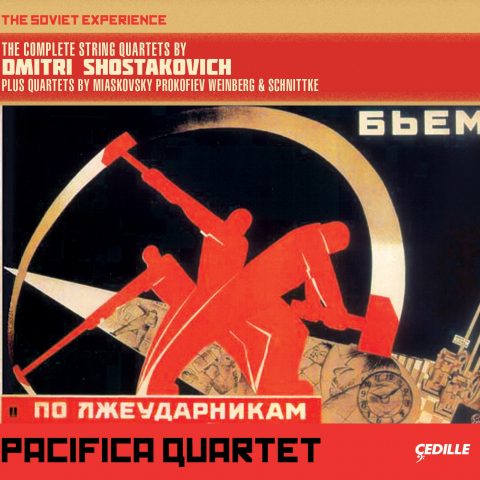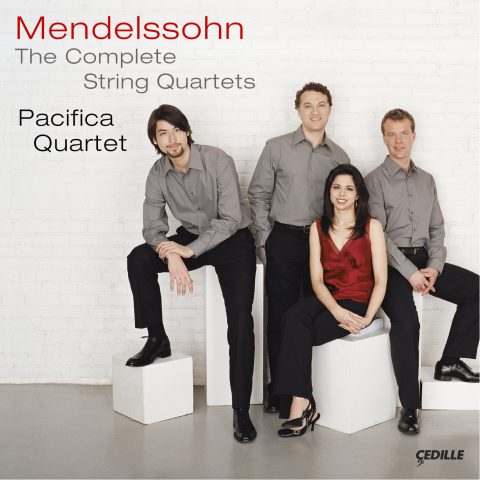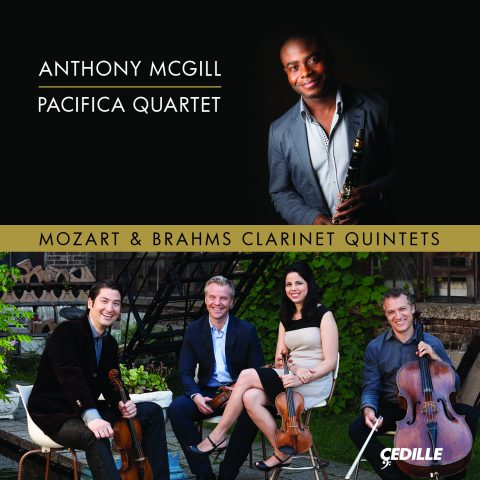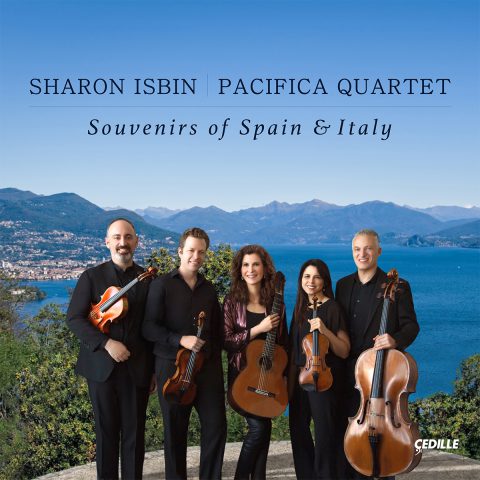| Subtotal | $18.00 |
|---|---|
| Tax | $1.85 |
| Total | $19.85 |
Store
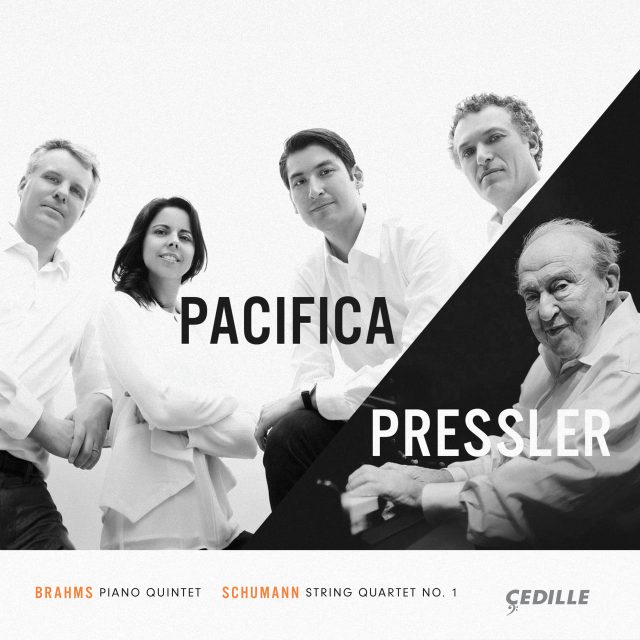
The internationally celebrated, Grammy Award-winning Pacifica Quartet joins forces with legendary pianist Menahem Pressler of the Beaux Arts Trio for Johannes Brahms’s Piano Quintet in F Minor, Op. 34, a pillar of German Romanticism that opens with one of the most recognizable melodies in classical music. Pressler, a consummate chamber artist, performs the virtuosic piano part with a clarity and transparency that makes the piano seem like a fellow member of the string ensemble.
This noteworthy generation-crossing collaboration — a half-century separates the pianist, who is in his 90s, from the quartet members — yields a spacious, sweeping traversal of the Brahms Quintet that sets its own pace to build suspense and drama. While Pressler has performed the Brahms Quintet with marquee string quartets of the past 50 years, this is his first recording of it.
The album offers the unusual, perhaps unprecedented, pairing of Brahms’s early Piano Quintet with a string quartet by his champion Robert Schumann, in this case, the String Quartet in A Minor, Op. 41, No.1, which the Quartet has been performing since early in its career. Dedicated to Mendelssohn, this buoyant, sprightly Romantic quartet showcases the Pacifica’s virtuosity and exuberant performance style while offering a contrast to Brahms’s moodier masterwork. This is the Quartet’s first recording of a Schumann work.
Currently quartet-in-residence at Indiana University’s Jacobs School of Music, the Pacifica Quartet was previously quartet-in-residence at New York’s Metropolitan Museum of Art and the University of Chicago. The Quartet received the 2009 Grammy Award for Best Chamber Music Performance and that same year was named “Ensemble of the Year” by Musical America. German-born pianist Menahem Pressler was a founding member of the illustrious, long-lived Beaux Arts Trio. The recipient of a Gramophone magazine Lifetime Achievement Award, he currently holds the rank of Distinguished Professor of Music at Indiana University’s Jacobs School of Music.

Listen to Steve Robinson’s interview
with Pacifica Quartet on Cedille’s
Classical Chicago Podcast
Preview Excerpts
JOHANNES BRAHMS (1833-1897)
Piano Quintet in F minor, Op. 34
ROBERT SCHUMANN (1810-1856)
String Quartet No. 1 in A minor, Op. 41, No. 1
Artists
Program Notes
Download Album BookletBrahms Piano Quintet / Schumann String Quartet
Notes by Robert Strong
Johannes Brahms (1833–1897)
Piano Quintet in F Minor, Op. 34
When Brahms was twenty, his compositions attracted the attention of Joseph Joachim, one of Europe’s leading violinists, who introduced him to Robert Schumann. Amazed by the quality of Brahms’s compositions, Schumann extolled the younger composer in an influential music journal as “one of the elect” who would “give an ideal expression of our times.” Brahms was instantly famous. Despite this, he failed to win appointment to the orchestra in his native Hamburg, where the Philharmonic directors never forgot that he came from that city’s slums and, as a teenager, helped support his family by playing piano in dockside bordellos. He settled in Vienna, where he rose to prominence as the acknowledged heir to the classical Viennese masters.
Brahms came of age when the innovations of Berlioz, Liszt, Wagner, and others were radically changing the style of music composition. Brahms was torn because he viewed himself as a preserver of the great classical music tradition of Haydn and Mozart, but he was also drawn to the more powerful expression of emotion found in the new romantic music. His model was Beethoven, who blended tradition and innovation in music with strong emotional impact. Laboring to match the great Beethoven was a burden Brahms found hard to bear. “You do not know,” he wrote, “what it is like to hear [Beethoven’s] footsteps constantly behind me.”
Cautious and famously self-critical, Brahms worked carefully, revising frequently and (unlike Beethoven!) often seeking the opinions of others. This was especially true of the Piano Quintet Op. 34. Brahms first composed it as a string quintet with two cellos. After rehearsal, Joseph Joachim, now Brahms’s close friend and advisor, told Brahms it “lacked charm.” Brahms transformed the piece entirely, but he and Joachim both felt this version was too orchestral for a string quintet. Brahms re-wrote the piece as a sonata for two pianos. This time Clara Schumann, Robert Schumann’s widow, intervened to suggest that the warmth of strings would be better suited to many of the work’s ideas. Brahms revised the material yet again into its final form as a piano quintet. It combines virtuoso playing in the piano part with the full range of expression from a string quartet and is now considered one of the greatest chamber music masterpieces.
The dark first movement begins quietly with a brief thematic statement played in unison by the piano, cello, and first violin. This is followed by a passage of forceful running notes in the piano. Though seemingly unrelated, the running notes are a faster, rhythmically modified version of the opening statement transposed into a different key. British musicologist Ivor Keys has shown that the entire first movement is built from these two brief statements. That Brahms could build such an epic movement from so little musical material shows his mastery of thematic variation.
The lyrical Andante is a serene refuge from the tumult and majestic sweep of the first movement. Clara Schumann described it as “one long melody from start to finish.” Though its mood is sunny, it is mixed with tinges of melancholy.
The Scherzo’s driving rhythm begins quietly in the cello’s opening pulse under a sinister rising theme. The movement builds quickly through a syncopated passage to a full-voiced, heroic march. As in the first movement, Brahms weaves these brief early statements into an extended musical texture that is grand in scale. The Scherzo is propelled forward by a strong rhythmic beat. Syncopation and frequent use of half-step notes and harmonic shifts impart an agitated intensity to the music. The trio section provides some respite, but tension remains in the ceaseless syncopated undercurrent. The Scherzo returns, and the movement surges wildly to its strong half-step ending.
The Finale opens mysteriously with deeply chromatic notes rising to strong chords. The strings sob and cry out over the piano’s chords in a mood of desolate sadness. After the introduction fades, the faster body of the movement continues the high drama by switching abruptly between different temperaments, some buoyant, some pleading, and some almost savage. A rushing coda leads to a false ending a hundred measures before the quintet rises passionately to its dramatic conclusion.
Robert Schumann (1810–1856)
String Quartet in A Minor, Op. 41, No. 1
Robert Schumann studied music and composed from a young age, but it was only at age twenty that he threw over his mother’s ambition that he become a lawyer and resolved to devote himself solely to music. During intensive training to be a concert pianist, he permanently injured a finger on his right hand, perhaps with an exercise device he designed to speed his training. This made a career as a concert pianist impossible, but he was undeterred and centered his musical ambitions on composition. He wrote of his intention to go beyond the confining limits of Classical music and express himself directly to “the human heart.” Music, in his view, was a universal force without boundaries. “I am affected by everything that goes on in the world — politics, literature, people… and then I long to express myself in music.”
He founded a magazine called New Journal For Music and became the most influential critic of the age, supporting young composers of the new Romantic movement and debunking those who he felt were too limited in their musical expression. He wrote articles for the magazine using two pseudonyms, each representing one side in the cultural debate — the passionate, forward-looking Florestan, who desires artistic freedom; and the restrained, deliberate Eusebius, who follows existing rules and conventions. He composed parts of his early piano compositions to reflect the temperaments of these two imaginary personas, most famously in Carnaval.
Schumann composed nothing but works for piano in his first nine years as a composer. In 1840, he composed nothing but songs, many of which were inspired by his love for the gifted pianist Clara Wieck, who he married that year after the couple’s long and acrimonious legal battle with her father. 1841 was a year of composing for orchestra. In early 1842, Schumann’s diary records that he began to have “quartet thoughts.” He prepared for this project between mid-March and early May by studying the music scores of Bach, Mozart, Beethoven, and Haydn. He began composing in June with his usual manic intensity and completed the three string quartets of Op. 41 in less than five weeks. By the end of the year he had also composed the Piano Quintet, the Piano Quartet, and a piano trio.
There was a great deal of Schumann’s alter ego Florestan in his own highly emotional personality. Throughout his adult life he suffered from mood swings and veered between extremes of buoyant creativity and depression. His chamber music has an impulsive, improvisational quality and is composed in sharply contrasting moods and styles that often change abruptly. This pattern (Florestan vs. Eusebius, if you will) is evident in String Quartet in A Minor, Op. 41, No. 1.
After opening with a slow, somber contrapuntal introduction in the quartet’s home key of A minor, the first movement changes to a bright song in the key of F major (the “wrong” key according to convention). A spiky, heavily accented passage in a darker mood interrupts the song repeatedly, but the contest is resolved when the song gently closes the movement.
The Scherzo combines energetic rhythmic galloping with music of elfin delicacy in the style of Mendelssohn, to whom the quartet is dedicated. The sighing Intermezzo section is an oasis of calm in contrast to rushing Scherzo.
A brief passage of pensive recitative in the cello and violin opens the Adagio to introduce the movement’s beautiful main theme. Schumann’s talent for song writing is clearly heard in the tender aria. After a pause, the music becomes more agitated, still lyrical but with a dramatic edge that is no longer tender. The original song gradually re-emerges, and the cello ends the movement with a return to the opening recitative.
The final movement is high-spirited and witty. A perpetual motion series of rapid running notes drives the movement along in exciting fashion. Schumann explores the running note series in a variety of ways: upside down, as counterpoint, with gypsy inflections, expanded to orchestral proportions, and, near the movement’s end, as a slow bagpipe tune over droning accompaniment. After pausing for a solemn chorale, the running notes race to the quartet’s exuberant close.
© 2016 Robert Strong
Album Details
TT: (71:39)
Producer/Engineer: Judith Sherman
Editing: Bill Maylone
Editing Assistance: Jeanne Velonis
Additional Post Production: James Ginsburg and Steve Rodby
Recorded: November 19-21, 2014 (Brahms) and May 2-3, 2016 (Schumann) in Auer Hall at Indiana University
Graphic Design: Twin Collective
Cover Photos: “Menahem Pressler” by Julien Mignot
“Pacifica Quartet” by Lisa-Marie Mazzucco
© 2017 Cedille Records/Cedille Chicago
CDR 90000 170
